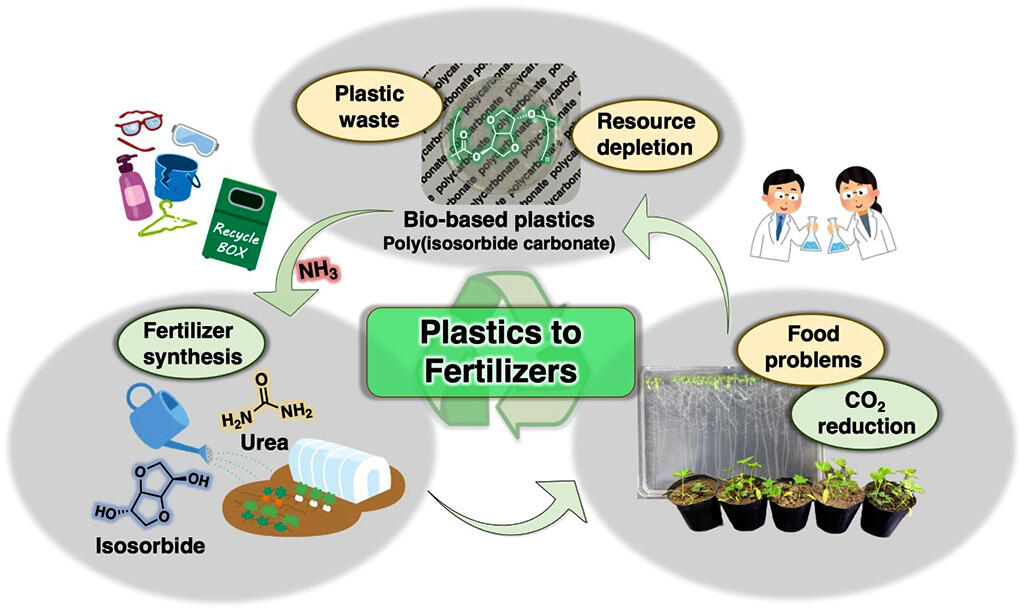A research group composed of Takumi Abe (graduate student), Assistant Professor Daisuke Aoki (JST PRESTO Researcher (concurrent)), Professor Hideyuki Otsuka, and others of the Department of Chemical Science and Engineering at the Tokyo Institute of Technology, in collaboration with the University of Tokyo and Kyoto University, announced that it has demonstrated a recycling system that decomposes plant-based plastics with aqueous ammonia and converts them into fertilizers. They synthesized plastic (polyisosorbide carbonate, "PIC") using plant-derived isosorbide as a monomer and confirmed that it can be decomposed into isosorbide and urea by a simple process involving the use of ammonia in water and under heated conditions. It was also confirmed that the growth of thale cress was promoted by the addition of the obtained decomposed plastic. This result is expected to contribute to solving issues surrounding plastic waste. The findings were published by the Royal Society of Chemistry in the October 28 issue of the journal Green Chemistry.

Provided by Tokyo Institute of Technology
Plastic has become an indispensable part of our daily lives as it is inexpensive and durable; however, in recent years, new problems such as marine pollution have emerged as a result of its use. On the other hand, most of the plastic produced is landfilled or incinerated, and the pure recycling rate constitutes only a low percent. In an attempt to solve this issue, the research group investigated whether carbonate-bonded plastic (polycarbonate:PIC) synthesized by polymerizing plant-derived isosorbide could be decomposed into urea, which is used as a chemical fertilizer, by reacting it with ammonia, with the aim of developing a new recycling system.
First, PIC with carbonate bonded isosorbide in the main chain skeleton was synthesized by polymerizing isosorbide. The optimum conditions when reacted with ammonia in water were then investigated. When ammonia was added and heated to 90 °C , the bond strength increased 30-fold over that of carbonate. PIC was completely decomposed into isosorbide and urea in 6 h. When PIC was decomposed, isosorbide and urea were produced in a ratio of 1:0.7. Although complete conversion requires a 1:1 ratio, the group confirmed that a 0.3 portion of the carbonate was released as carbon dioxide.
Using the obtained product, a growth test of thale cress was conducted with the cooperation of Associate Professor Takehiro Kamiya of the University of Tokyo and Professor Keiji Numata of Kyoto University. For thale cress, a fertilizer-free group, isosorbide-added group, urea-added group, and decomposition product-added group (urea + isosorbide) were considered, and the growth of each was observed. There was almost no difference between the fertilizer-free area and isosorbide-added area. However, growth was promoted in the urea-added group and further promoted in the decomposition product-added group. Although only from preliminary experiments that are yet to be published, similar results have been obtained with other plant species. Researchers are currently investigating the reasons for the promotion of growth by the simultaneous addition of isosorbide and urea.
The plastic currently used is derived from petroleum, meaning that it cannot be used as a fertilizer as it emits CO2 during production and disposal. However, the plant-derived PIC proposed in this study emits almost no CO2 during production and disposal, and decomposition does not require a catalyst. Current challenges to its use include high costs; nevertheless, social pressure can possibly promote its mass production and price reduction to drive a switch from the currently used plastic. The research group confirmed that it can be modified and will further investigate whether these plastics can also be used as fertilizers. Assistant Professor Aoki concluded, "In the future, I would like to develop a new PIC-based plastic derived from this concept. If we can turn plastic into fertilizer, we could develop a new system that goes beyond the goal of carbon neutrality."
This article has been translated by JST with permission from The Science News Ltd.(https://sci-news.co.jp/). Unauthorized reproduction of the article and photographs is prohibited.




